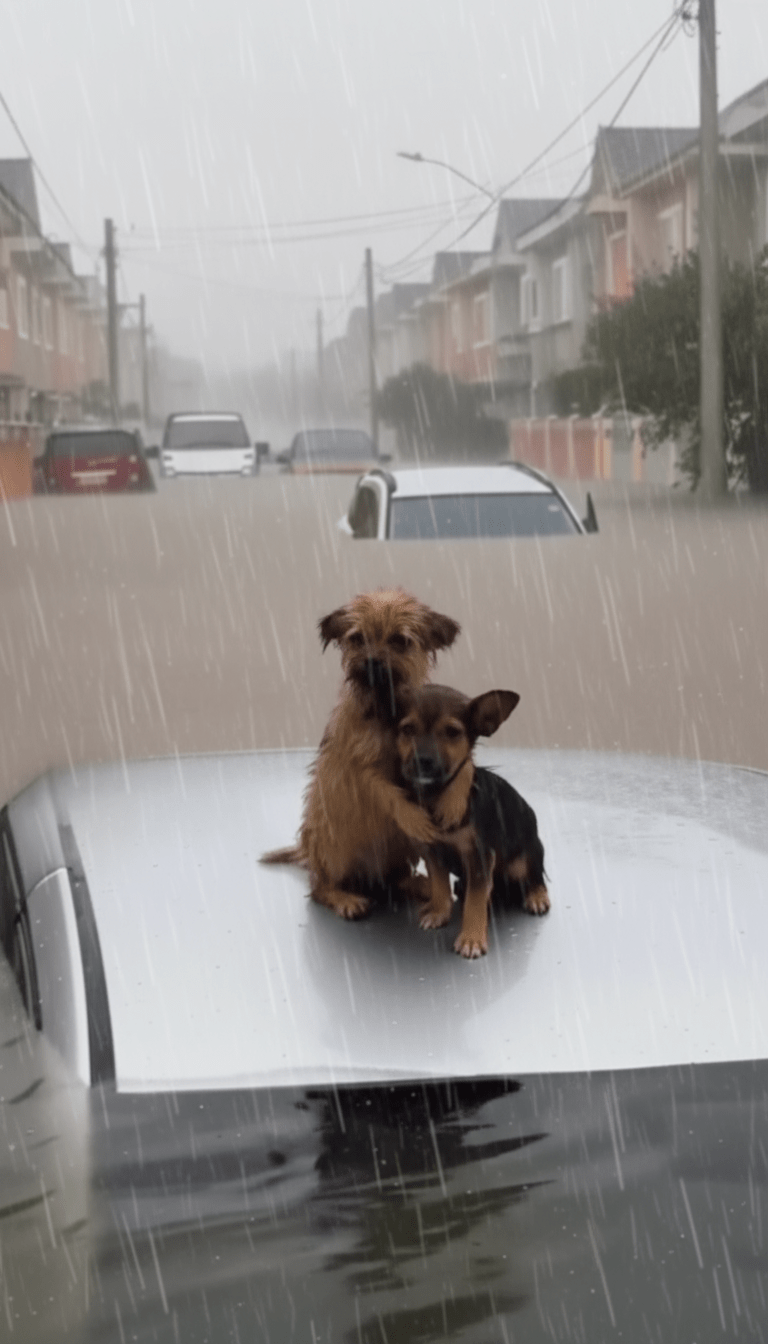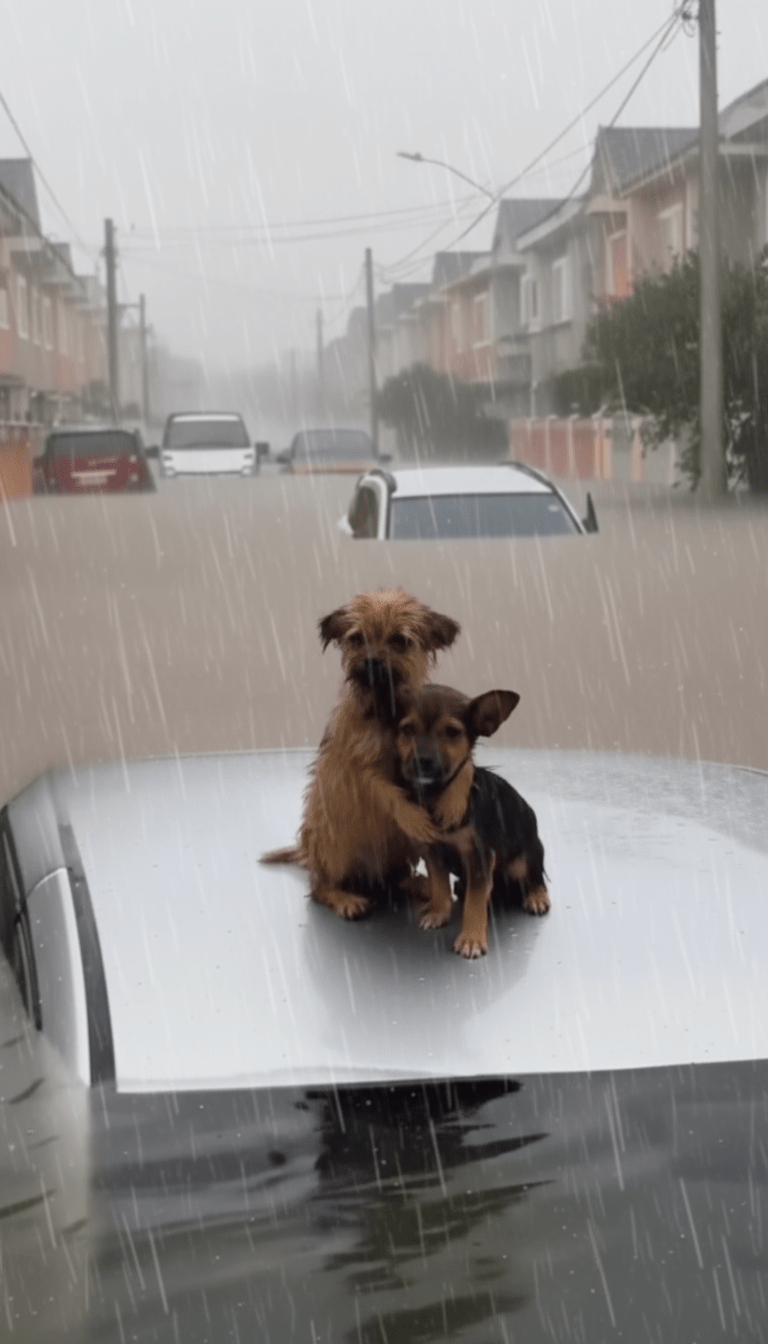In the early hours of May 3, 2024, the skies over Porto Alegre, the capital of Brazil’s southernmost state of Rio Grande do Sul, opened with a ferocity that meteorologists later described as a once-in-a-century deluge. What began as routine autumn rain escalated into a catastrophic flood that submerged entire neighborhoods, displaced over 600,000 residents, and claimed more than 170 lives across 478 municipalities. Rivers burst their banks, highways turned into rivers, and homes—some built over generations—vanished beneath chocolate-brown torrents. Yet amid the chaos, a single photograph captured on a rain-lashed residential street in the Menino Deus district would travel the world, not for the scale of destruction it framed, but for the quiet, defiant tenderness at its center: two small dogs, soaked to the bone, clinging to each other atop the roof of a half-submerged white sedan as floodwaters raged around them.

The image, taken by freelance photojournalist Mariana Keller at 7:42 a.m., shows a scruffy terrier mix with matted golden fur wrapped protectively around a smaller, black-and-tan companion. Their ears are flattened, eyes wide with instinctual alarm, but their bodies press together in a posture that speaks less of fear and more of resolve. The car beneath them—a 2018 Volkswagen Gol—had been abandoned hours earlier when its owner, local baker Carlos Mendes, fled rising waters with his elderly mother. By dawn, the vehicle sat in nearly four feet of floodwater, its hood serving as the only dry perch within a 200-meter radius. How the dogs arrived there remains one of the flood’s enduring mysteries, but their story—pieced together through eyewitness accounts, social media traces, and veterinary records—reveals a chain of improbable events that began long before the rain.
The larger dog, later identified as Café, belonged to 12-year-old Luana Silva, who lived three blocks away in a modest two-story home. Café had been a gift on Luana’s eighth birthday, a rescue from a shelter in nearby Canoas. The smaller dog, Preto, was a stray who had appeared in the neighborhood six months prior, scrounging scraps from bakery dumpsters. Residents recall that Café and Preto formed an unlikely alliance: the housed dog sharing his bowl, the stray guarding the gate at night. “They were inseparable,” said neighbor Ana Clara Ramos. “Café would wait at the corner every evening for Preto to finish his rounds. If Preto didn’t show, Café refused to eat.”
When the floods struck, Luana’s family evacuated to a shelter at Colégio Dom Bosco, leaving Café behind in a moment of panicked oversight. Security camera footage from a nearby pharmacy, recovered weeks later, shows Café breaking through a flimsy backyard fence at 4:17 a.m. as water surged past the doorstep. Ten minutes later, the same camera captures Preto sprinting alongside him, both dogs weaving through debris-choked alleys. Veterinary microchip records confirm both animals were scanned at a temporary rescue center 48 hours after the photo went viral—meaning they survived not just the flood, but the treacherous journey to higher ground together.
The photograph’s global resonance began when Keller posted it to her Instagram with the caption: “Their story wasn’t about the rain, but about the unbreakable bond that keeps you steady when the world floods.” Within 24 hours, the image had been shared over 2.1 million times, translated into 14 languages, and featured on the cover of O Globo. Hashtags #DoisCachorros and #IrmãosDeEnchente trended worldwide. In Japan, a Tokyo-based animator created a 30-second short film depicting the dogs’ imagined journey. In Germany, a Berlin brewery released a limited-edition stout named Café & Preto, donating proceeds to flood relief. Even the Brazilian Air Force referenced the pair in a press conference, with Colonel André Pereira noting, “If two small dogs can find each other in that chaos, imagine what coordinated human effort can achieve.”
But the story’s most unexpected twist came on May 17, when a second photograph surfaced—this one taken by a drone operated by the Civil Defense. It showed Café and Preto on the same car roof, now pushed by currents into the Guaíba River’s main channel. The vehicle had drifted nearly two kilometers downstream, yet the dogs remained perched together, unmoved by the jostling. Rescuers in a Zodiac boat reached them at 11:03 a.m., using a catchpole to lift Preto first, then Café, who refused to board until his companion was safe. Veterinarians at the field hospital noted minor hypothermia and paw pad lacerations but no life-threatening injuries. “They were dehydrated but alert,” said Dr. Sofia Almeida. “And they wouldn’t let us separate them for treatment.”

The dogs’ reunion with Luana occurred three days later at the shelter, captured in a now-iconic video: the girl sprinting across the gymnasium floor, Café barreling into her arms, Preto trailing close behind. The moment prompted an outpouring of donations—over R$400,000 in the first week alone—funneled through a crowdfunding campaign titled “Um Teto para Café & Preto” (A Roof for Café & Preto). The funds rebuilt not only Luana’s flooded home but also financed a community pet evacuation protocol, including elevated kennels and microchip registration drives.
Yet the ripple effects extended far beyond Brazil. In July 2024, the image inspired a similar rescue protocol in Valencia, Spain, where autumn flash floods had repeatedly caught authorities off-guard. City officials installed “pet perches”—raised platforms in flood-prone parks—modeled on the Volkswagen’s accidental role. In Houston, Texas, where Hurricane Harvey’s 2017 floods had separated countless pets from owners, animal welfare groups launched the Café & Preto Challenge, encouraging residents to microchip pets and designate flood reunification points. Even in New Zealand, where the 2023 Auckland floods displaced thousands, schoolchildren wrote essays about the dogs, with one 10-year-old concluding: “Love isn’t loud. Sometimes it’s just two wet dogs refusing to let go.”
Scientists, too, took note. Behavioral researchers at the University of São Paulo published a preliminary study in Animal Cognition suggesting that inter-species bonds—like that between a domesticated terrier and a former stray—may activate heightened protective instincts under extreme stress. “Café didn’t just tolerate Preto,” wrote lead author Dr. Renata Costa. “He chose him, repeatedly, in conditions where self-preservation should have dominated.” The study cited thermal imaging from the rescue boat showing the dogs’ body temperatures stabilizing only when in physical contact—a physiological echo of their emotional bond.
By November 2024, Café and Preto had become unofficial ambassadors for flood preparedness. They appeared (via pre-recorded video) at the United Nations Climate Conference in Baku, Azerbaijan, where Brazil’s environment minister referenced their story to underscore the human-animal intersection in disaster response. A children’s book, Dois Cachorros, Uma Enchente, sold 120,000 copies in its first month, with illustrations depicting the dogs navigating a surreal, waterlogged Porto Alegre—past floating pianos, upside-down buses, and a lone soccer ball bobbing like a buoy.
Today, the white Volkswagen Gol sits in the courtyard of Porto Alegre’s Museum of Contemporary Art, preserved as a monument. Its roof bears two faint paw prints, etched into the paint by weeks of rain and pressure. Visitors leave dog treats at its base, a quiet tribute to the animals who reminded a grieving city that survival is not always about strength, but about refusal to drift apart.
In the end, Café and Preto never performed heroic feats in the human sense—no dramatic swims through raging currents, no guiding lost children to safety. Their heroism was quieter, more profound: a daily choice, renewed with every lap of water against the car’s tires, to stay. In a world increasingly defined by displacement—climate refugees, economic migrants, families torn by conflict—their story whispers a stubborn truth: sometimes the smallest anchors hold the longest.
And somewhere in Menino Deus, on clear evenings when the Guaíba glints gold at sunset, residents swear they still see two shadows trotting side by side along the rebuilt levee—one golden, one black-and-tan—pausing only to sniff the air, as if checking that the rain, for now, has decided to stay away.






